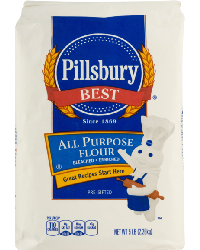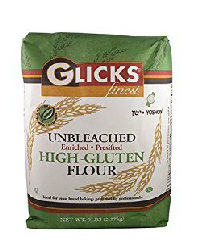 Homepage
Sitemap
Site Search
Homepage
Sitemap
Site Search
Flour for baking and cooking, what flour should you buy?
Here is a little help on understanding the different types of flour and how they can be used without getting into the scientific and professional bakery stuff! So you want to bake bread, make a cake or use flour to make fried chicken---what should you buy?



|
Other flours: Bread Flour, for an example, King Arthur Bread flour, is 12.7% protein and is great for breads, pasta and pizza. There are many protein levels depending on the brand with some as high as 13.4% protein. For crustiness and chew it's my first choice. FYI, you can add vital wheat gluten to increase the protein level for even chewier results especially when making bagels. Consider these two commercial bakery flours--- ADM Regal® flour is a professional bread baker's flour. The protein is 14.2%, it has excellent mixing tolerance and excellent absorption properties. Regal is ideal for bagels; Kaiser rolls; thin-crust pizza; and Italian, French and Jewish breads. Another ADM flour is Cavalier® with protein at 14.3%. If you’re looking for a high-protein flour with a slightly darker crumb, its unmatched fermentation tolerance makes it perfectly suited for sourdough and specialty breads. |
Pastry flour comes in at about 9% protein. Professionally and even for home bakers, pastry flour is the way to go for flaky pie dough, Danish pastry and cookies. It absorbs a bit less water so you will get a better blend of ingredients and less toughness. You will also see whole wheat pasty flour in markets, it's okay but I still think the good old white pastry flour is without equal for my pie dough and cookies!
|
White Whole Wheat flour, fairly new to the market, is milled the same way as whole-wheat, but using hard white wheat berries instead of red wheat and it has a sweeter flavor. It's a good choice for homemade bread; choose white whole wheat flour instead of all-purpose or combine half and half in your next bread or pizza dough recipe. Whole Wheat Flour is rich in nutrients and dietary fiber, but it poses some challenges for beginning bakers because it usually absorbs water differently than white flour and may need the addition of gluten to reduce crumbliness. Still it makes wonderful and flavorful health breads. |
Self-rising flour is a blended mix that combines all-purpose flour, salt and a leavening agent. It is a convenience to have everything already to go if you like making biscuits, pancakes, or cornbread. National brands of self-rising flour to look for are Gold Medal and Pillsbury.
Semolina and Durum flours…Semolina is actually just a type of flour made from durum wheat at 13 to 13.5% protein, it is granular and is coarser than most milled flours. If you make pasta, you’ll definitely need semolina. Don't get confused with cornmeal---it is not the same. In Italy semolina is also used for some breads and to make polenta instead of using cornmeal.
Durum flour is an unbleached flour left over from the milling process from the hard durum wheat and also a product of semolina that's ground further. Durum flour is used for making pasta, noodles and some specialty breads. If milled coarsely and cooked it is cous-cous and even a delicious breakfast porridge with butter, cream and nutmeg!
|
Cake flour, cakes made with all-purpose flour may have too much gluten, making them tough and dense. Bread made with all-purpose flour may not have enough gluten, making it too fragile. If you are a perfectionist, using cake flour for cakes is recommended. Why? Cake flour contains less protein than all-purpose flour which means it will produce a tenderer product and is also bleached by design. Swans Down and Softasilk cake flour come in at 7.5 to 8.5% protein. Bake cakes, quick breads, muffins and pancakes with it and they will be light with a nice crumb. The next time you bake a cake, you’re going to want to have some cake flour on hand. |
There are even more considerations such as pH, ash content and moisture content in flour and they all play a role in professional baking. As a home baker you will most likely only need four types of flour in your kitchen. A good brand of all-purpose, a cake flour, a whole wheat and a bread or high-gluten flour. Depending where you live, your grocery store shelves will have all you need!
|
00 Flour is worthy of mention if you make pizza dough, Scali and Italian bread! It is a very fine-textured flour a/k/a Italian pizza flour and may also be known as Manitoba flour. It's protein content hovers between 8-12%. It produces a dough that is easy to work with: handles well, is smooth and easy to shape. The resulting baked goods are light, airy, and have a crisp snap to the crust and a nice crumb. It's ideal for focaccia and pasta too albeit a bit expensive. Caputo is a popular brand from Naples, yet there are many others as 00 is just the measure of the milling fineness. |